In this article you will learn difference between Null and Alternative Hypothesis with examples.
In statistical tests, the null and alternative hypothesis reflect two opposed suppositions or statements. The null and alternative hypotheses are two opposing assertions that researchers use a statistical test to analyze evidence for and against: The main distinction is that the null hypothesis rejects the phenomenon or event proposed by the alternative hypothesis or research hypothesis. As a result, the statement describing the null hypothesis is tested statistically using t-tests and linear regression. The statement describing the alternative hypothesis is compared to the null hypothesis. Proving the null hypothesis implies that the alternative hypothesis is rejected.
The alternative and null hypotheses provide conflicting answers to your research question.
Does the independent variable affect the dependent variable?
Null hypothesis H0: No, there is not
Alternative hypothesis Ha : Yes, there is.
Null Hypothesis
- It suggests that there is no effect on the population
- It describes that Dependent variable in the study is not changed by the independent variable.
- The symbol H0 represents the null hypothesis.
- The outcome or effect is created by chance, according to the null hypothesis,
- There is no relationship between the two variables.
- The null hypothesis is usually based on prior research or specialized expertise.
- Contain terms like “no effect,” “no difference,” or “no relationship.”
- Simple, composite, exact, and inexact hypotheses are the four primary categories of null hypotheses.
- Include equality =, but sometimes ≥ or ≤ when expressed in arithmetic.
- A type I error occurs when you incorrectly reject the null hypothesis.
- A type II error occurs when you incorrectly fail to reject it.
Alternative Hypothesis
- It could be based on insufficient evidence or belief
- It denotes the effect on the population
- It describes that the independent variable effects the dependent variable.
- The alternative hypothesis is denoted by the sign H1 or Ha
- It can be one-sided (directional) or two-sided (non-directional).
- Contain terms like “an effect,” “a difference,” or “a relationship.”
- include an inequality ≠ , but sometimes < or >.
Null Hypothesis and Alternative Hypothesis
| Research Questions | Null Hypothesis | Alternative Hypothesis |
| Does following a healthy lifestyle ensure happiness? | A healthy lifestyle has no effect on happiness. | A healthy lifestyle has an effect on happiness. |
| Does the attendance of student affect his performance in exams? | The attendance of student has no effect in his performance in exams. | The attendance of student in the textbook has an effect in his performance in exams. |
| Does daily exercise decrease the panic attacks? | Daily exercise does not decrease the incidence of panic attacks. | Daily exercise decreases the panic attacks. |
Difference between Null and Alternative Hypothesis
| Null Hypothesis | Alternative Hypothesis |
| No relationship between two variables | There is a relationship between two variables |
| Researcher tries to disprove | Researcher tries to prove |
| H-null, H-zero, or H0 | H1 or Ha |
| =, ≤, ≥ | ≠,<,> |
| No effect, No difference, No relationship, No change, Does not increase, Does not decrease | effect, difference, relationship, change, increases, decreases |
| Accepted- results of study become insignificant | Accepted- results of study become significant |
| Indirect and implicit | Direct and explicit |
| P-value is greater than the level of significance p > | P-value is smaller than the level of significance p < |
✔ The null hypothesis is a broad statement stating that there is no relationship between two variables in a study or that no association exists between two groups.
✔ An alternate hypothesis, on the other hand, is a statement that describes the existence of a relationship between two variables in a study.
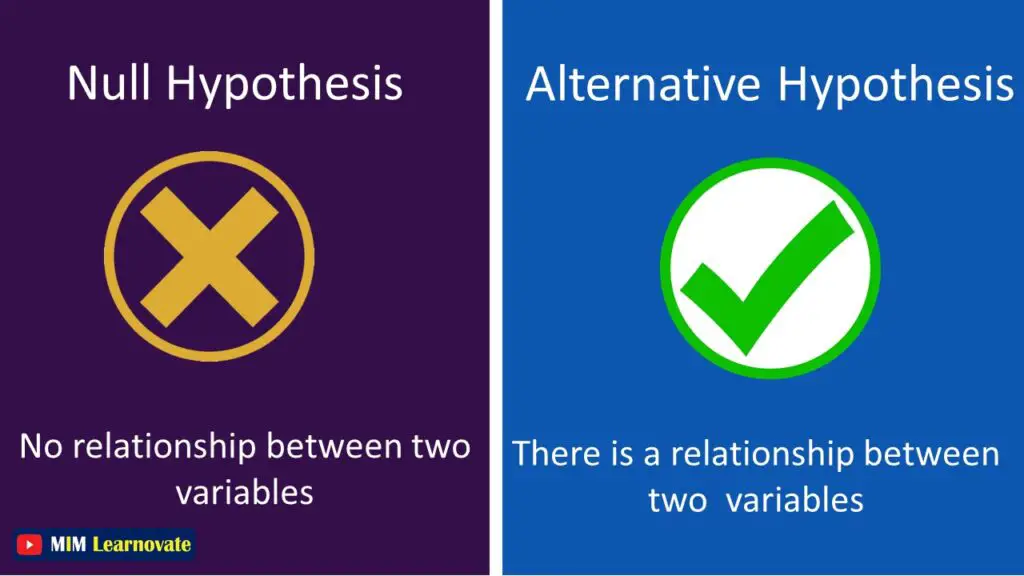
✔ A null hypothesis is the hypothesis that a researcher is attempting to refute.
✔ The alternative hypothesis, on the other hand, is the hypothesis that the researcher attempts to confirm.
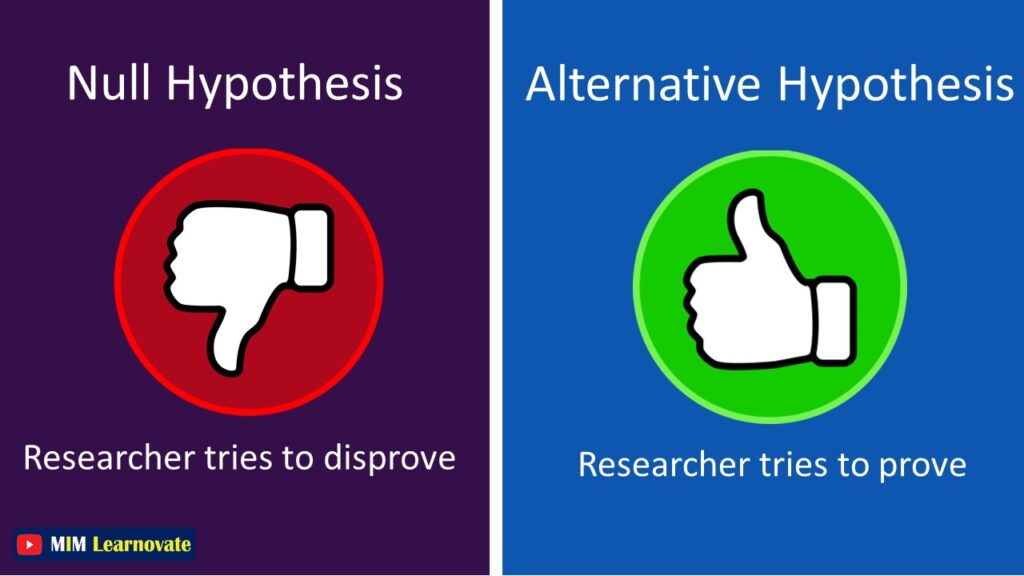
✔ H0 denotes a null hypothesis, which can also be read as H-null, H-zero, or H-naught.
✔ Alternate hypothesis is denoted by H1 or Ha.
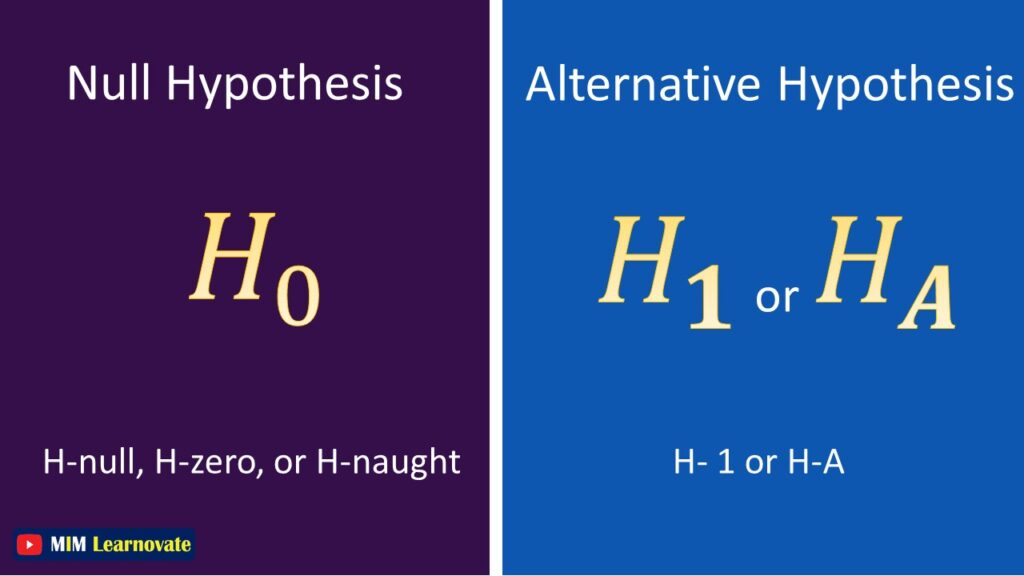
✔ Null Hypothesis is followed by a ‘equals to’ sign in a mathematical expression.
✔ The sign not equals to, ‘less than,’ or ‘greater than’ follows Alternate Hypothesis.
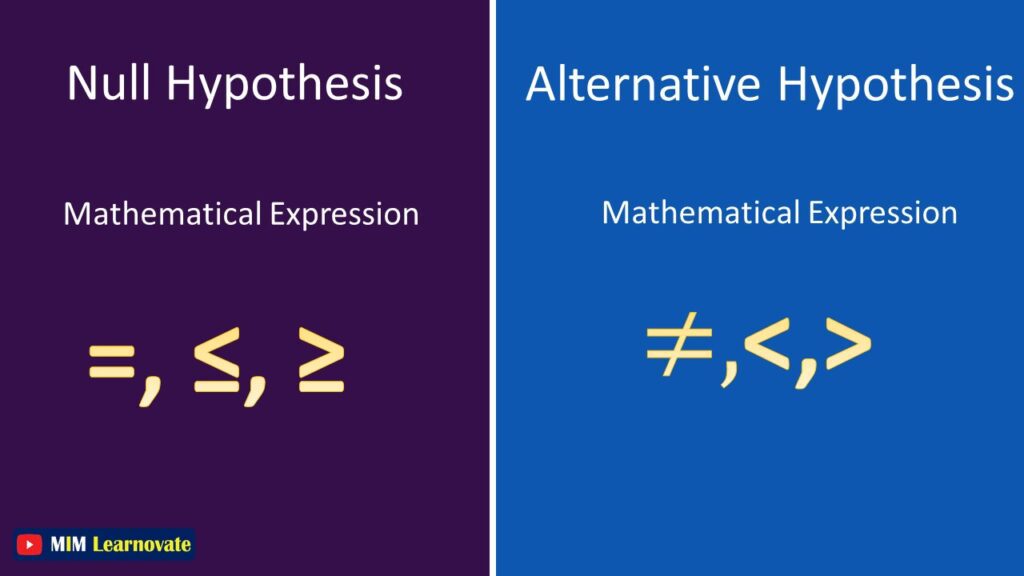
✔ If the null hypothesis is adopted, the study’s findings become insignificant.
✔ If an alternate hypothesis is accepted, the study’s findings become relevant.
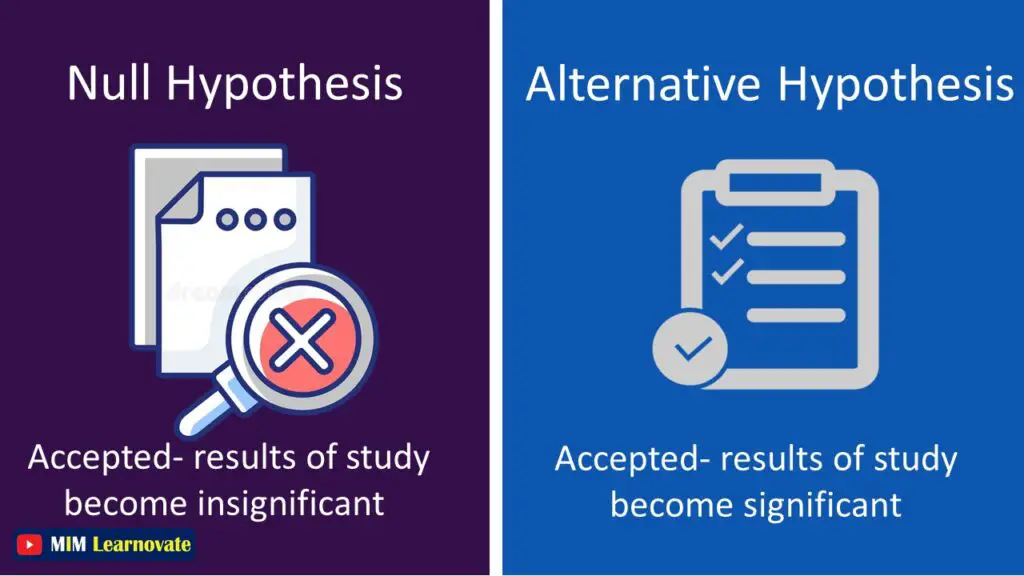
✔ Testing is indirect and implied in the null hypothesis.
✔ Testing is direct and explicit in alternate hypothesis.
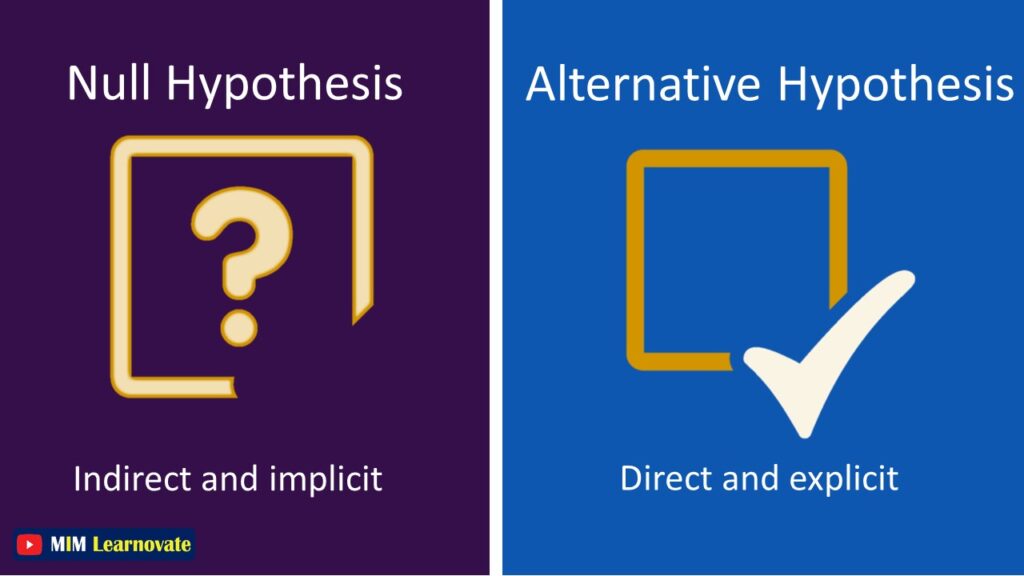
✔ The null hypothesis is accepted if the p-value is greater than the level of significance.
✔ if the p-value is less than the level of significance, the alternative hypothesis is accepted.
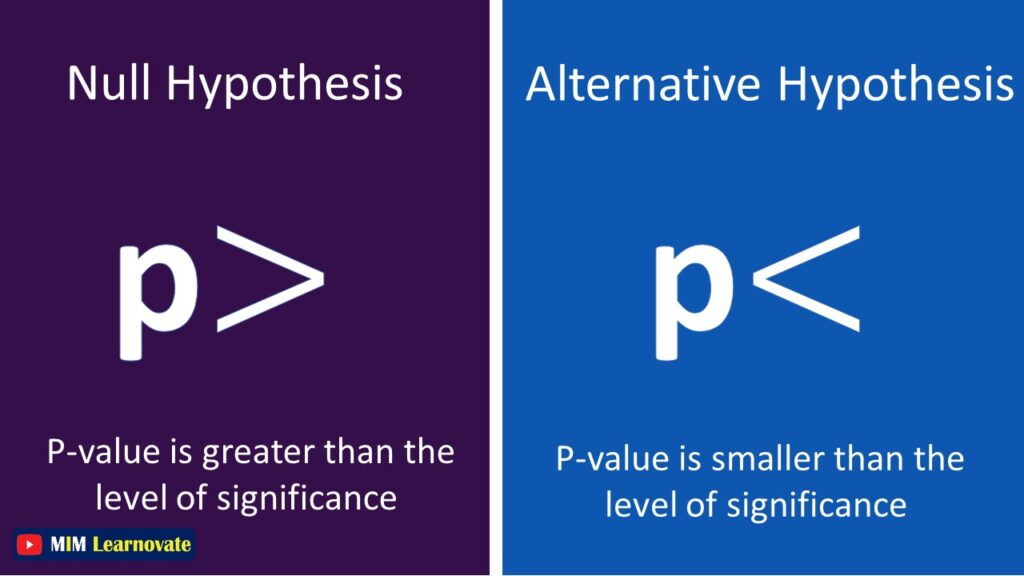
Examples of null hypothesis and an alternative hypothesis
Let’s look at how to write a null hypothesis and an alternative hypothesis.
Assume that a researcher believes a bridge’s carrying capacity is greater than 10 tons.
Null Hypothesis: H0: µ= 10 tons Alternative hypothesis: Ha: µ > 10 tons
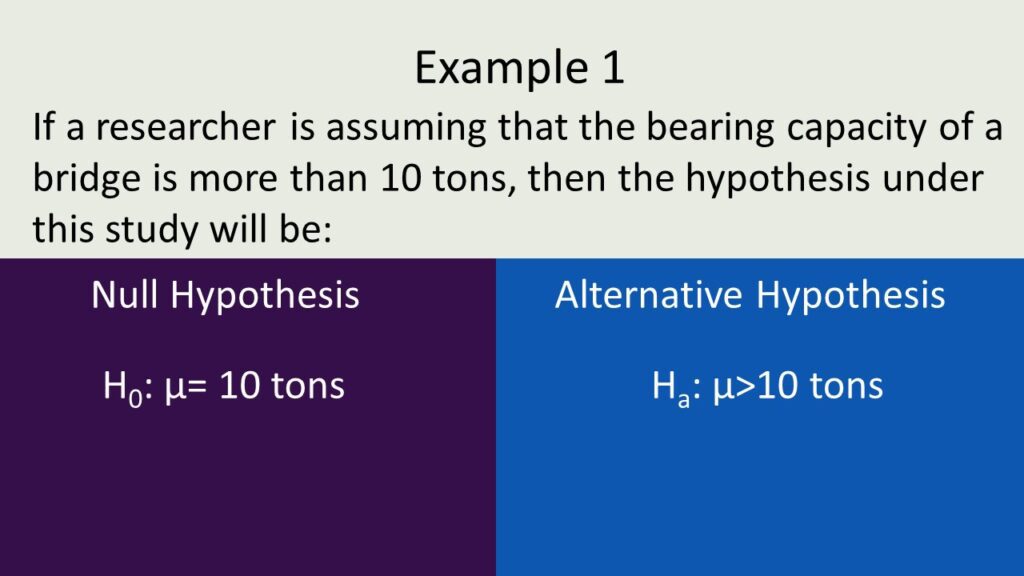
There is a difference in work ethic values between American and Asian employees. μAM denotes the mean work ethic value of Americans, and μAS denotes the mean work ethic value of Asians.

Women are more motivated than males. μM the mean motivational level of males, and μW the mean motivational level of women
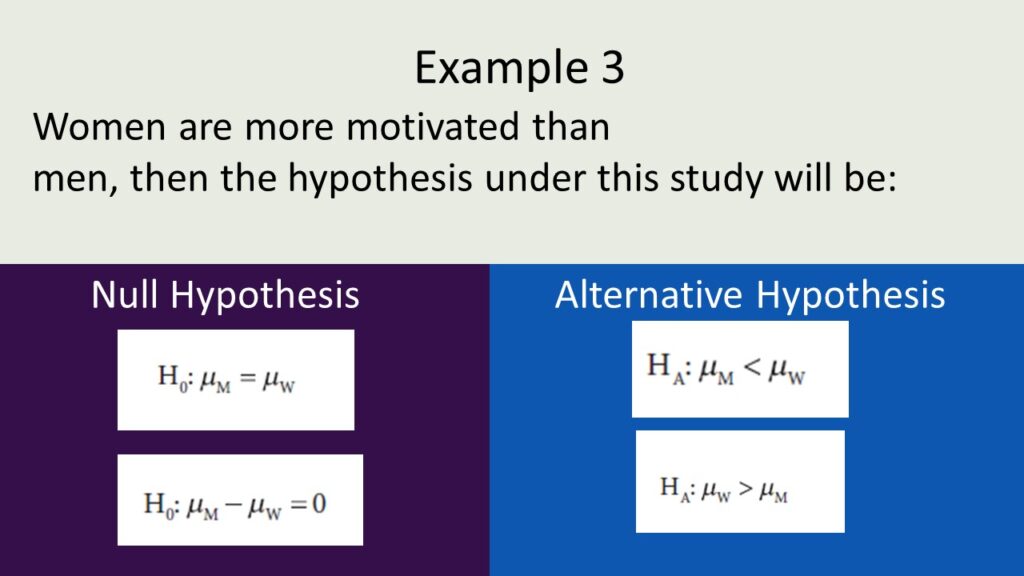
Similarities between Null Hypothesis and an Alternative Hypothesis
In several aspects, null and alternative hypotheses are similar:
✔ Both are answers to the research question.
✔ They make population-related assertions.
✔ Statistical tests are used to examine null and alternative hypothesis.
Other articles
Please read through some of our other articles with examples and explanations if you’d like to learn more about research methodology.
Citation Styles
- APA Reference Page
- MLA Citations
- Chicago Style Format
- “et al.” in APA, MLA, and Chicago Style
- Do All References in a Reference List Need to Be Cited in Text?
Comparision
- Basic and Applied Research
- Cross-Sectional vs Longitudinal Studies
- Survey vs Questionnaire
- Open Ended vs Closed Ended Questions
- Experimental and Non-Experimental Research
- Inductive vs Deductive Approach
- Null and Alternative Hypothesis
- Reliability vs Validity
- Population vs Sample
- Conceptual Framework and Theoretical Framework
- Bibliography and Reference
- Stratified vs Cluster Sampling
- Sampling Error vs Sampling Bias
- Internal Validity vs External Validity
- Full-Scale, Laboratory-Scale and Pilot-Scale Studies
- Plagiarism and Paraphrasing
- Research Methodology Vs. Research Method
- Mediator and Moderator
- Type I vs Type II error
- Descriptive and Inferential Statistics
- Microsoft Excel and SPSS
- Parametric and Non-Parametric Test
Comparision
- Independent vs. Dependent Variable – MIM Learnovate
- Research Article and Research Paper
- Proposition and Hypothesis
- Principal Component Analysis and Partial Least Squares
- Academic Research vs Industry Research
- Clinical Research vs Lab Research
- Research Lab and Hospital Lab
- Thesis Statement and Research Question
- Quantitative Researchers vs. Quantitative Traders
- Premise, Hypothesis and Supposition
- Survey Vs Experiment
- Hypothesis and Theory
- Independent vs. Dependent Variable
- APA vs. MLA
- Ghost Authorship vs. Gift Authorship
Research
- Research Methods
- Quantitative Research
- Qualitative Research
- Case Study Research
- Survey Research
- Conclusive Research
- Descriptive Research
- Cross-Sectional Research
- Theoretical Framework
- Conceptual Framework
- Triangulation
- Grounded Theory
- Quasi-Experimental Design
- Mixed Method
- Correlational Research
- Randomized Controlled Trial
- Stratified Sampling
- Ethnography
- Ghost Authorship
- Secondary Data Collection
- Primary Data Collection
- Ex-Post-Facto
Research
- Table of Contents
- Dissertation Topic
- Synopsis
- Thesis Statement
- Research Proposal
- Research Questions
- Research Problem
- Research Gap
- Types of Research Gaps
- Variables
- Operationalization of Variables
- Literature Review
- Research Hypothesis
- Questionnaire
- Abstract
- Validity
- Reliability
- Measurement of Scale
- Sampling Techniques
- Acknowledgements
Statistics
- PLS-SEM model
- Principal Components Analysis
- Multivariate Analysis
- Friedman Test
- Chi-Square Test (Χ²)
- T-test
- SPSS
- Effect Size
- Critical Values in Statistics
- Statistical Analysis
- Calculate the Sample Size for Randomized Controlled Trials
- Covariate in Statistics
- Avoid Common Mistakes in Statistics
- Standard Deviation
- Derivatives & Formulas
- Build a PLS-SEM model using AMOS
- Principal Components Analysis using SPSS
- Statistical Tools
- Type I vs Type II error
- Descriptive and Inferential Statistics
- Microsoft Excel and SPSS
- One-tailed and Two-tailed Test
- Parametric and Non-Parametric Test



